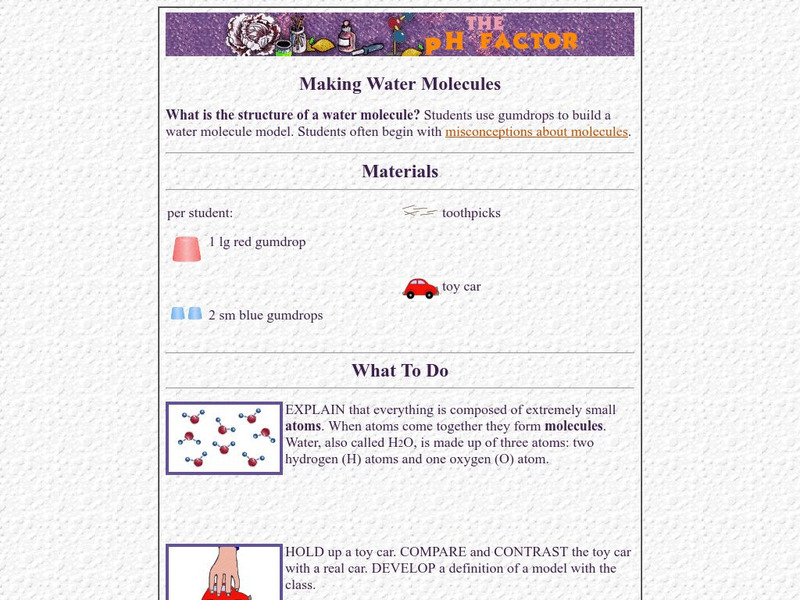American Chemical Society
Middle School Chemistry: Lesson Plans: Water Is a Polar Molecule
Students develop their own water molecule model to help them understand the idea that water has a slight positive charge at one end of the molecule and a slight negative charge at the other.
Concord Consortium
Concord Consortium: Molecular Workbench: Water Molecules & Carbon Nanotubes
View this simulation to observe how water molecules move through carbon nanotubes.
Museum of Science
Miami Museum of Science: Making Water Molecules
This simple lesson involves making a model of a water molecule from gumdrops. A toy car is also used to explain how a model compares to the real thing.
University Corporation for Atmospheric Research
Ucar: Just a Phase: Water as a Solid, Liquid, and Gas
This site helps students construct a model of the arrangement of water molecules when present as solid, liquid or gas. Includes background information, lesson plans, links to standards and assessment ideas.
Concord Consortium
Concord Consortium: What Happens to the Energy of Water Molecules During Hurricanes?
In this investigation students will add energy to the model of how molecules interact by completing the following activities. Activity 1 What does boiling do to water molecules? Activity 2 How hot can water go? Activity 3 How does energy...
American Chemical Society
Middle School Chemistry: Lesson Plans: Why Does Water Dissolve Salt?
Students use their own model of a salt crystal and water molecule to show how water dissolves salt. Then, they relate their observations to the structure of salt, water, and alcohol on the molecular level.
Concord Consortium
Concord Consortium: Molecular Workbench: Water and Polar Substances
Adjust amounts of ionic charges in this simulation to see how water molecules react to polar substances in solution.
American Chemical Society
Middle School Chemistry: Changing State: Evaporation
Students build a model of a water molecule and design an experiment to see if adding energy affects the rate of evaporation.
Other
Chemical Education Digital Library: Carbonic Acid H2 Co3
A 360 degrees view virtual model of a carbonic acid molecule. Students can manipulate the model to explore its properties.
Other
Beautiful Chemistry: Molecular Structures
These models show the structures of some basic molecules such as water and carbon dioxide, then move on to show more complex molecular strautures.
Concord Consortium
The Concord Consortium: Molecular Workbench Micelle Formation
Watch how micelle formation changes in a solution with water compared to a solution consisting of oil.
Utah STEM Foundation
Utah Stem Action Center: Salt Dissolved in Great Salt Lake
In this lesson, students will compare water from a fresh lake to water from the Great Salt Lake to begin to build a conceptual model for how salt dissolves in water. The lesson focuses on students using and developing models of molecules...






